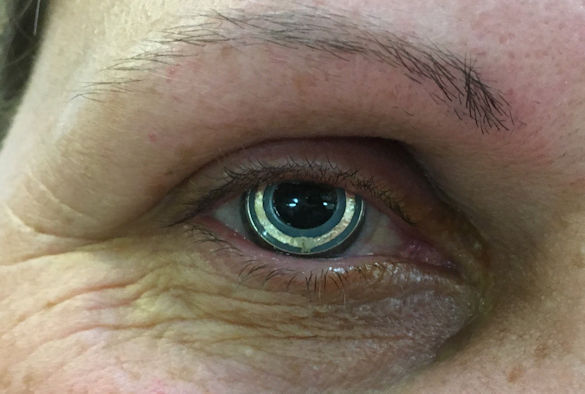A novel contact lens device developed by University of Liverpool engineers to improve the treatment of glaucoma has been found to reliably track pressure changes in the eye and be wearable by people who took part in its first clinical study.
The contact lens device is able to continuously measure fluid pressure in the eye – known as intraocular pressure (IOP) – the elevation of which is a cause of glaucoma and if not managed can lead to loss of vision.
Currently IOP is measured in glaucoma patients during clinic visits which are usually twice a year, but this characterisation of IOP is unreliable as IOP is dynamic and easily affected by psychological and environmental factors – such as stress or sleeping.
The device, which is made of a soft silicone hydrogel material to ensure it is comfortable to wear, contains a pressure sensor which detects changes in IOP continuously over a period of up to 24 hours. These changes are then transmitted wirelessly to an easily portable external controller (the size of a mobile phone) which collects the data and provides clinicians with much needed, but currently unavailable, data to assist with glaucoma treatment.
A small scale, first in man, clinical study of the novel device involved 12 volunteers who wore the new contact lens device for more than an hour while under constant clinical observation has been completed at St. Paul’s Eye Unit in the Royal Liverpool University Hospital and at Moorfields Eye Hospital in London.
Results from the study found the device was able to measure changes in the IOP, with minimal impact and little discomfort to the patient.
Glaucoma is a leading cause of irreversible blindness, affecting 0.5million people in the UK (67million worldwide) and costing the NHS more than £1billion a year. The aim of glaucoma treatment is to control IOP in order to minimise further damage, and avoid loss of vision.
The device has been developed by University biomedical engineers in conjunction with engineers from specialist contact lens manufacturer, Ultravision CLPL, St Pauls Eye Unit, Liverpool and Moorfields Eye Hospital, London. The development team is now looking to refine manufacturing techniques in order to take the device to the next step towards commercialisation.
Ahmed Elsheikh, Professor of Biomaterial Mechanics in the University’s School of Engineering, said: “The results of this study are very positive and show that the device is comfortable for people to wear and gives good measurements of the IOP.
“This device has the potential to provide millions of sufferers of glaucoma with much needed information which will ensure that they are being treated correctly, and that their good vision can be maintained and damage kept to a minimum.”
Funding to develop the device and to support the clinical study was provided by the National Institute for Health Research.
